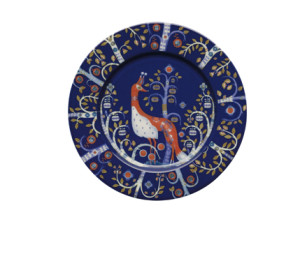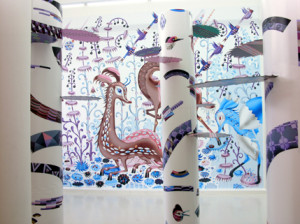Arabia’s gallery in Helsinki features this summer the first explorations by visual artist and illustrator Klaus Haapaniemi into the world of ceramics. The idea was born when he was working on his Taika decor for Iittala. Taika was launched this spring. The images featured in the exhibition are in essence very classical. Many of them are floral- and fauna-based, containing elements drawn from Finnish urban architecture and mythical animal figures.
Haapaniemi has worked with numerous international fashion houses since the 1990s, including Diesel, Dolce & Cabbana, and Cacharal. Haapaniemi is well-known for his innovative approach. He combines traditional illustrative techniques with the latest visual trends. Much of his inspiration coems from a very wide range of visual cultures.
Kaipiainen en Orvola
The designs in the works on display at the Arabia Gallery have been transferred directly to the surfaces of dishes and plates from Birger Kaipiainen’s Paratiisi range and Heikki Orvola’s 24h range. Klaus Haapaniemi describes the works as follows: “These prints combined influences ranging from pop art to the baroque and the world of folklore,” he says.
“Garnier Sevres’ porcelain prints from the end of the nineteenth century were a particularly important source of inspiration.”
Forest and Cityscapes
Haapaniemi’s images draw on references from a variety of sources – landscapes, buildings, animals, and other beings combine to create a unique world of their own. Many of the mythical animals featured are hybrids and include human features. The worlds conjured up by Haapaniemi initially appear to be straightforward and easily understandable, but the more the viewer looks at them, the more he or she will find there. He likes to play with archetypical contrasts: setting forest against cityscapes, wild animals against domesticated animals and pets, and the traditional against the contemporary. This emphasis on contrasting images creates an in-built tension that forces viewers to look beyond the glowing colours and figures on the surface to what lies underneath. And ask themselves, is the giant frog sitting in front of that fairytale castle a prince or really a witch in disguise? Or is the frog a metaphor for today’s hero worship hysteria?
Rich and deep colours
Each of the unique pieces has been hand-produced by applying the print to a basic white porcelain surface to bring out its contrasts and rich, deep colours. His work with fashion houses has taught him how print designs and colours work with fabrics, and he is very excited about bringing this expertise to ceramics. “I wanted to make use of the same styles and techniques that I’ve used with my textile prints. Ceramic is a very interesting material in this respect, as its surface is almost metallic in terms of colours, but at the same time is very fragile in comparison.”
“I wanted to make use of the same styles and techniques that I’ve used with my textile prints.”
Pro Arte
All of Haapaniemi’s unique pieces have been produced by hand at the Arabia plant by its Pro Arte department. Heli Honkatukia was responsible for ensuring that the transfers matched the pieces and for screen printing them, after which they were applied by hand and the pieces glazed and fired. Jeon Min Kyung and Heidi Launonen were responsible for applying the images in accordance with Klaus Haapaniemi’s instructions. Taipa that magic means comes in various items in blue and white as a dominant color. There are six different items in changing color. A small white and a large blue plate. A large blue mug and a small white espresso cup. Taipa combines very well with the new colours of the 2007 colours of iitalla’s Kartio, Aino Aalto en Teema: sand and ultramarine. All together these services gives you innumerous possibilities to combine items. Never a dull moment anymore at your table. Perhaps even a touch a magic might come to it by Taipa.
(June 12, 2007, by Leslie Leijenhorst)



